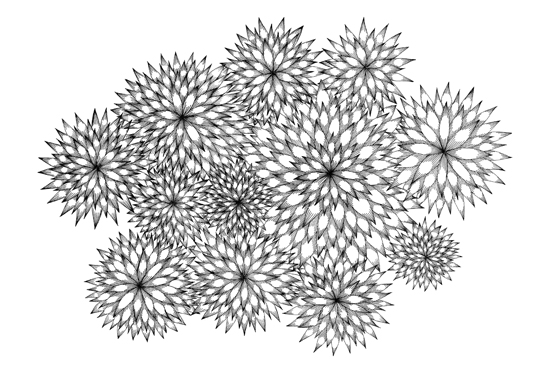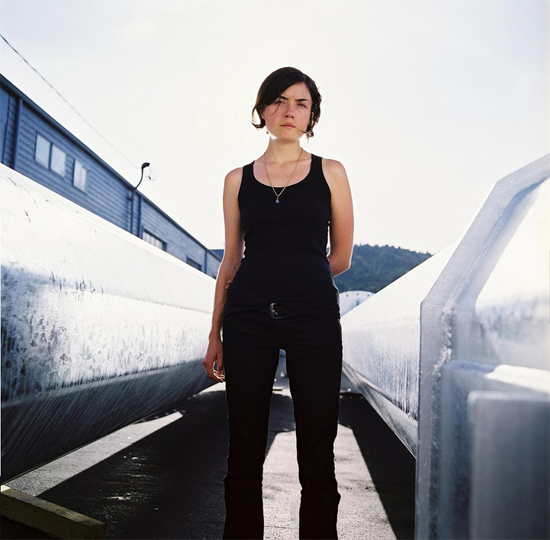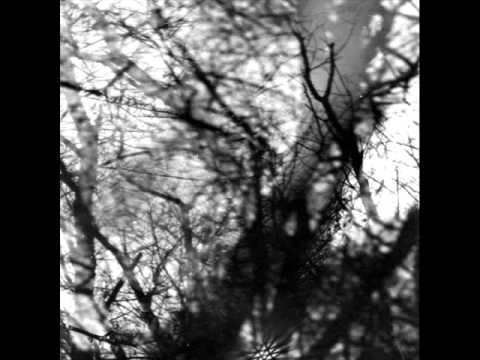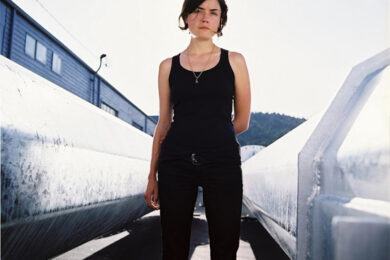Shaking Mirrorring’s Foreign Body LP from its slipcover, a flimsy piece of paper falls free and drops into your hand alongside the record. A white drawing on a charcoal grey background, it depicts a pair of thick rings interlinked and overlapping to the extent that a third shared space is opened up between them, forming an unusually decorative Venn diagram. The drawing is by one half of Mirrorring, Liz Harris, who over the past few years has become known and well-loved for her solo recordings under the name Grouper. It’s in keeping with many of the drawings and sketches she’s displayed in galleries and on her website, all repeated motifs whose edges splay into one another and ostensibly simple, blocky structures picked out in near-impossibly fine, impressionistic pencilwork.
As well as being striking in their own right, Harris’ drawings rather neatly represent the interests at play throughout her artistic output. Where a brief glance at her work across various media might initially suggest it to be painted in broad strokes, closer inspection reveals it as intricate and possessed of miniscule, careful detailing. As with her other drawings, Foreign Body‘s sleeve insert is concerned with the spaces between delimited spaces, the liminal zones where two worlds overlap or press against one another. Here it’s displayed very directly, as the third region within the Venn diagram. In others it’s subtler: pencil-sketched flowers whose petals meld at the edges into intricate cross-hatch; geometric shapes in stark white against backgrounds of densely pattered grey.
The same preoccupations inform Grouper’s music, which has long felt interested in the border regions around sleep states and the tapping of the subconscious. Her songs – suffused with tape hiss, awash in delay and pricked with field recordings that crackle around the edges of audible range – tend to feel both astral in logic and somnambulistic, as if the listener themselves were being permitted to sleepwalk right into the heart of Harris’ own dreams. Fittingly, she started making these drawings at exactly the same time she begun recording as Grouper, she tells me over email, during a follow-up exchange to an earlier Skype conversation.
"The drawings ground me," she says. "I have a part of my brain that I have not yet found a way to turn off, that is constantly assessing what is in front of me and trying to make it fit the grid, put it where it goes. [It’s] really disruptive at times, like working on a slow computer, the Mac rainbow wheel spinning. Probably related to being spacey and a perfectionist at the same time. There’s no way I’ll ever get it right." For Harris, placing her experiences into some form of order allows her to take control of her own need to organise the changing world around her. "The drawings, and the songs too, are a way of trying to love and own that," she explains. "Up close the lines wobble, the edges don’t meet, but that’s what makes them work. And once that web is illuminated, wobbly or not, I can finally relax. Part of what is cool about being alive is risking coexistence with our flaws."

Since the release of her debut album Way Their Crept in 2005, whose artwork featured the very first of Harris’ drawings as a fold out poster, these processes have given rise to a remarkable body of work. Based in Portland, Oregon, her work is rooted in the US cassette/CDr underground – she has released split albums with Xiu Xiu and Inca Ore, there are shades of fellow explorers The Skaters and Yellow Swans in the near-mantric, ragged vocal/guitar work of her debut, and the muggy, narcotic-addled moods of her early work echo the likes of Stars Of The Lid. But her output has remained slippery and hard to pin down, stretching across formats (CD, LP, 7", cassette, many self-released in limited runs) and forms, all the way from reverb-soaked, softly sung folk to tape-loop-based ambient composition.
Throughout this period, her music has remained unusually concerned with its own space. Generally hushed, inward-looking and cushioned from the outside world by an amniotic fog of delay and distortion, it’s intensely evocative of the natural world, tapping into cycles of change and decay through language – 2008 album Dragging A Dead Deer Up A Hill; song titles like ‘Soul Eraser’, ‘Water People’ and ‘Fishing Bird (Empty Gutted In The Evening Breeze)’; certain repeated motifs that crop up again and again, in particular water and wind. The same ideas are reflected in the sound of her music, its grainy, lulling washes summoning the muffled crash of breaking waves, translucent curtains of water vapour or softly undulating hills and fields. But they’re portrayed at a remove, landscapes the listener is invited to explore through the mediating lens of Harris’ own experience, rather than depicted with photorealistic accuracy.
"I do translate everything I see and experience towards visualization of another space," she agrees, though she admits it’s not a conscious process. "Sort of like a camera obscura, somehow each additional bit of information from this plane [the ‘real’ world] goes towards painting in more details on another. Sort of poltergeisting, black hole projections."
Last year Harris released a stunning pair of albums under the banner title of A I A. Gathering some of her finest work to date, they marked her first full-length releases since Dragging A Dead Deer Up A Hill and, in contrast to that album’s clear structures, further mapped that abstract ‘other’ space. Split into Dream Loss and Alien Observer, there was something quite definitive about A I A‘s contents, spanning as they did the full breadth of Harris’ work to date – everywhere from the more secretive, noisy meditations of earlier albums Way Their Crept and Cover The Windows & The Walls to the more unadorned songwriting of later work.
"The stuff on A I A was recorded over the span of several years," she says, a marked contrast to her previous albums which were generally made in the space of a couple of weeks. Working at a very time-intensive full-time job, she had found herself without the time or space to record in the same way as she had previously. "I had two years or more worth of material I’d avoided touching, because I didn’t yet know what working on music looked like after I’d had to change my relationship with it due to work, other life changes, etc. I didn’t really know what any of it would be, until I sat down with all the material and started working on it. But I had been thinking about it that whole time, and slowly starting to see these twin planets emerging. It took more than a year following that to really pull into that shape. [It] felt like dredging a swamp, everything coming up half decomposed." It’s a process that’s far from over, she says, with several other albums from that time period still only in embryonic form.
Given Harris’ talk of mapping this world onto another imagined space, her titling one half Alien Observer feels appropriate: its title could easily be describing that experience of projecting inward from outside. It’s perhaps telling, too, that it’s the lighter and warmer of the two. ‘Mary On The Wall’ is devoid of real structure save the slow lullaby of a music box, and there’s an appealing openness to songs like the title track, with its near-childlike take on detachment from this reality: "Going to take a spaceship / Ride back to the stars / Alien observer / In a world that isn’t ours".
Dream Loss, by comparison, is starker and more detached. Across its eight tracks her voice frequently sinks lower into the mix than it has on any of her work for several years. Opening song ‘Dragging The Streets’ finds Harris herself fraying at the edges, crumbling away until she merges with the backdrop entirely. Throughout its length her presence is tangible but always out-of-focus, a psychic residue smeared across the landscape’s surface. These places are wild and untamed, finding her buffeted by stinging wind, disembodied pianos and roaring guitar that call to mind Leyland James Kirby’s spectral samplework as The Caretaker, or Richard Skelton’s hollowed-out explorations of Yorkshire moorland.
"Dream Loss ended up mining the past heavily," she says of that album’s weightier feel. "Those songs were written during the beginning of that time I mentioned when I was thinking of tons of songs, but having trouble recording any of them. I felt really haunted by them, lost children. Dream Loss was largely an attempt to go back and reconcile with all those little ghosts so that I could move forward. I had to acknowledge them somehow in order to do so. That process ended up reflecting a similar process I was going through emotionally – trying to process some big life changes so that I could move forward."
A I A‘s two halves orbit one another like celestial bodies: both distinct entities in their own right, but each affected by the gravitational pull of the other. It’s something Harris has specifically discussed in past interviews, where she explained that the project’s overall title denotes both the two objects themselves (a pair of ‘A’s) and the resonant space between them (the ‘I’). Like her drawings, where the edges between zones are highlighted or obscured, the entire project was specifically intended to draw attention to that highly charged region where Alien Observer and Dream Loss rub up against one another. The exact nature of their interaction is, however, harder to isolate. "I think it is impossible to really describe what it is about though, because ultimately the dialogue between the two is about representation of something that can’t be represented," she warns. "It’s not just about me. In each of us is an infinite body of metaphorical microcosms bending back to consume themselves. The space between these albums is, on one level, talking about that space between us, between these eschalons, layers of folding worlds. The spaces between exist and do not at once. You can only look at and describe the area surrounding the divide. Try to touch directly and it wilts, dies.
"I also want to say I am not really deciding any of it," she continues, "just finding my way into rooms and describing the interior. I can tell you some of the themes that came up on their own. There is a water cycle described in the trajectory of the two. Dream Loss is trapped in waves, a kind of suffocating current, and Alien Observer is after the evaporation, a spreading into mist, hovering clouds. I am glad there was an uplift after all that dredging, though I think the songs are still ominous, as far as cloud personalities go."
Mirrorring, Harris’ new collaborative project with Tiny Vipers’ Jesy Fortino, addresses the same concerns in a number of ways. There’s the title of the duo’s debut album for Kranky, Foreign Body, with its implications of the invasion of one entity into another’s space ("I like that name because it feels kind of foreign and familiar at once," she smiles. "There’s something human and alien, and it’s happening at the same time"). There’s the music itself, a bold – if subtle – interlacing of two artists’ deeply personal approaches, where Fortino’s fuller bodied voice wrestles control away from Harris’ ebbing tape collages and muffled guitar, and where A I A-style roiling background radiation frequently threatens to swallow Fortino’s presence entirely. Then there’s the project’s title itself: look closely and you’ll spot an extra ‘r’ in there, creating a reflected image around the central ‘o’.
Also, I say, mirrors are often used as a cinematic device to amplify the sense of unreality in a scene, or to show the audience something the protagonist is blissfully unaware of.
"Or the classic horror movie thing, where something’s happening in the mirror that’s not happening in the other space," she laughs. "Yeah, I love the weird skewed sense of space that happens with mirrors, metaphorically and then literally – like having two mirrors next to each other, there’s an implied opened up space that doesn’t actually exist, or that you couldn’t enter if you wanted to."
Harris and Fortino met several years ago when they played a few shows together, and formed an immediate bond. "We definitely had an instant friendship, synergy, and we’re both fans of each other’s music," says Harris, so the decision to work together on a record was born out conversation, and a gentle suggestion from a mutual friend, Jefre Cantu-Ledesma, who runs the Root Strata label. "Our music is coming from a similar place, I think," she continues. Considering that both’s solo records tend to be closed-off, rather self-contained things, the process of bringing their musics together was "very easy. Well, not easy – just it wasn’t something we had to really work hard at in order to find that meeting place in the middle. It just sort of unfolded on its own, each of us brought our own sketches, and honestly, within a few days everything on that album pretty much unfolded on its own, based on the sketches we’d each brought to the table."
Outside recording, Harris has recently been hard at work on a number of other projects. Over the last month she has taken a show entitled Violet Replacement on the road around the UK and Europe. Based around a pair of longform tape collage pieces which originally took shape for commissioned performances in New York and Berkeley, it further sinks her presence deep into its surroundings, turning the mix inside out. Along similar lines, at Berlin’s Club Transmediale festival in early February of this year Harris premiered a new work called Circular Veil in collaboration with Cantu-Ledesma. Somewhere between an installation and a performance, it found her extending the pastoral drones and warm tape noise of her more concise music outward into seven hours of music, designed to mimic one full sleep cycle.
The idea for that performance was seeded during a conversation with friend, composer and sound artist Lawrence English. The pair had collaborated together, and he had told her about performances he used to take part in that were specifically designed for people to sleep to. "I’d heard a bit, here and there, about shows that used to happen like that in the nineties – maybe even as part of a rave culture thing – but I had already designed this one piece for Berkeley Art museum specifically to be music you could listen to and fall asleep during." While that piece was only an hour long – a far cry from Circular Veil‘s full seven hours – the conversation piqued Harris’ curiosity enough to attempt something grander in scale. "I ended up thinking about whether or not you could take those sort of tones and spread them out," she explains, "and literally make it something someone would sleep to – the length of an entire sleep cycle."
During the performance at CTM in the auditorium of Berlin’s HAU 2 theatre, the entire audience were arranged concentrically on cushions on the floor, radiating outward from Harris and Cantu-Ledesma. While the crowd drifted in and out of sleep, time perceptions thrown out-of-whack by undetectable shifts in the near-ambience surrounding them, the duo sat cross-legged and silent, manipulating an array of tape players. "I have trouble sleeping so it was really ironically torturous," she laughs of the performance, which took place from early evening until the early hours of the morning. "I didn’t sleep the whole night before, and I’m sitting here doing these hour-long fades, nodding in and out. But then on the other hand, it’s probably the only music you would want to play if you were sleep deprived!"
Leaving, we felt as though time had simply been postponed for the few hours we spent inside Circular Veil‘s bubble. Long conversations whispered amongst ourselves had acquired the elusive volatility of dream discourse, as if by mimicking a sleep space Harris had actually succeeded in opening in her audience that bridge between waking and dream. "I faded in and out," she nods. "And the time period of the piece ended up similarly psychedelic, or dissociative, for me while playing. That’s one thing Jef and I kept talking about – not really knowing how much time had passed, and having this oddly obscured perception of it, where you just couldn’t really tell."
Since the release of A I A a year ago, Harris has released only one recording as Grouper. A tiny, tantalising 7" containing the songs ‘Water People’ and ‘Moving Machine’, it’s a striking moment in her discography, and one that comes as something of a surprise given the more muted feel of her recent recordings: it finds her voice crisp and unadorned, standing clear in the foreground. ‘Water People’ – a link to the water cycle contained within Dream Loss and Alien Observer? – marks the most easily audible song of her career so far. Given her commitment to exploring border regions, it’s a reminder that the same battles between distance and proximity, gravity and weightlessness, structure and formlessness that lend her other projects their power are also played out in her consistent stretching of the notion of what a ‘song’ is, or could be.
"I don’t think of it as tension," she says of the relationship between song and non-song in her work. "I am really comfortable mixing together all these elements." So Harris’ art is capable of inhabiting any number of places along that continuum at once: it reaches from the nakedly pretty, opiate-soaked pop of 2008’s ‘Heavy Water/Rather Be Sleeping’, through A I A‘s push and pull between order and chaos, to the fully disassembled threads of her tape-loop compositions, before jumping between media, unravelling on the page, onscreen and through speaker cones. "Remaining honest is the most important continuity for me," she concludes. "Part of being honest and compassionate about what it means to be human involves assembling all the awkward parts together in the same room with what’s been polished, finding a way to incorporate the flaws into the pattern."
Mirrorring’s Foreign Body is out now on Kranky.
Drawing at top of article by Liz Harris, taken from Harris’ site Yellowelectric.
Grouper plays Counterflows Festival in London and Glasgow this weekend, with Michael Gira, Caspar Brotzmann and more. Read our preview for more details.




